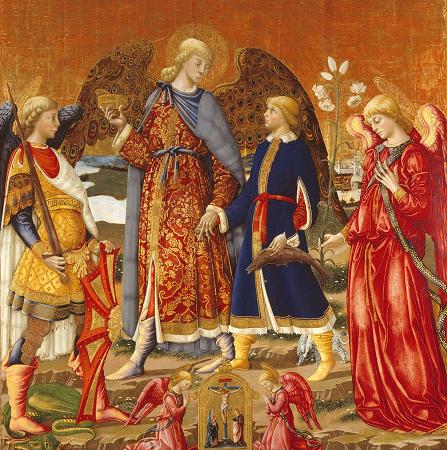Neri di Bicci (c1419 - c1491). Neri di Bicci was an Italian painter active mainly in Florence. A prolific painter of mainly religious themes, he worked in the medium of tempera. He studied under his father, Bicci di Lorenzo, who in turn had studied under his father, Lorenzo di Bicci. All three were part of a lineage of great painters beginning with Neri's grandfather Lorenzo who was a pupil of Spinello Aretino. Neri di Bicci's main works include a St. John Gualbert Enthroned, with Ten Saints for the church of Santa Trinita, an Annunciation in the Florentine Academy, two altarpieces in the Diocesan Museum of San Miniato, a Madonna with Child Enthroned in the Pinacoteca Nazionale of Siena, and a Coronation of the Virgin in the abbey church at San Pietro a Ruoti. The Ricordanze are a series of journals Neri kept from the years 1453-1475. They include the rates of remuneration for his work, his pupils, and lists of their works. They are the most extensive 15th century document we have relating to a 15th-century painter and are still preserved in the library of the Uffizi Gallery. When Neri was born in 1419 he was the third in a line of Bicci family artists. It began with his grandfather Lorenzo di Bicci who was a contemporary of Jacopo di Cione and Niccolo di Pietro Gerini. Lorenzo di Bicci is most famous for his Triptych, but also created many notable Madonnas. Neri's father was also an artist and worked closely with the grandfather Lorenzo helping to create many of his commissions. Neri spent a lot of time in his father's workshop and in his first works this is evident from their extremely similar style. At only the age of 15, in 1434, Neri joined the confraternity of Saint Luke. This confraternity was started as early as 1349 and although it was not part of the official guild system, many artists joined due to the lack of an official artist guild. By 1572, however, it would finally become an official guild of Florence and be filled with many of the best painters and sculptors. There was much confusion, as documented later, as to who art historians attributed the Bicci family work to. In Giorgio Vasari's Lives of the Artists he confused Neri as being the second son of Lorenzo and therefore brothers with Bicci. Much of Bicci's work was subsequently falsely attributed to Neri. These false attributions were not corrected until 1768 in Domenico M. Manni's edition of Baldinucci's Notizie dei professori del disegno. This mistake was reiterated in Gaetano Milanesi's commentary to Vasari's Vite in 1878. Neri created works for people in all different social classes ranging from the upper bouerghoise, to members of the florentine guilds, to humble provincial churches. In 1439, there is the first documented work that Neri collaborated with his father on. This trompe-l'oeil was a funerary monument to Luigi Marsili and was frescoed by them both in the Florence Cathedral. Then in 1440, Neri painted and dated an Annunciation in San Angelo a Legnaia with his father. By 1444, Neri began creating his own art beginning with a painted triptych Virgin and Child Enthroned with Six Saints for the chapel of San Giacomo in Santissima Annunziata. In this work it is clear that Neri's style had evolved and moved away from being similar to his father to being more like the styles of Fra Filippo Lippi and Paolo Schiavo. In 1447, we know Neri painted a predella which is now untraceable for San Martino in Maiano. Although we do not have the painting, we know it was completed due to documented records of a payment being received thirteen years later on August 27, 1460. In 1452 Neri's father, Bicci, died and Neri was given control over the workshop. Also in this year Neri was commissioned to create a fresco cycle illustrating scenes from the Life of St Giovanni Gualberto for the Spini family chapel in Santa Trinita, more specifically commissioned by Giovanni Spini and Salvestro Spini. The only part of the fresco that survives to this day is the depiction of the annunciation over the entrance arc. Neri was most likely influenced by Fra Angelico and Domenico Veneziano which is deduced from his treatment of hair and garments. Neri's altar piece style often included advanced use of extreme foreshortening in the architecture. These two Archangel Raphael and Tobias pieces were most likely created one after the other. 1.1 was created in the workshop between 1457 and 1463, while 1.2 in the early 1460s. The subject of the Archangel was extremely popular in Florence in the 1460s and artists such as Francesco Botticini and Piero del Pollaiuolo illustrated this bible story. Although some works similar to the two seen here can be attributed to Jacopo da Sellaio, a higher proportion are from Neri's workshop. 1.1 and 1.2 are clearly very similar in terms of style and the way the characters are arranged.
more...













